Fly-in season
Don’t let self-induced pressure ruin everyone’s day
With these events comes a certain amount of pressure, most of it self-induced. We want to make it to the event, we want to perform our best and have a nice buttery landing in front of our friends, and we want to prove we’re good pilots just by showing up. But the focus on getting there can often distract from mounting threats like fuel concerns and task saturation. Almost every year, an unfortunate and preventable accident occurs when someone’s on their way into or out of a fly-in. But with some extra attention on the proper preparation, we can avoid this. This season, here are a few tips to make sure you have a backup plan and make it to your fly-ins safely—even if that means (horror of horrors) canceling and driving in.
Fuel is a key concern when under pressure. For fly-ins and airshows like Oshkosh, you will need to fly a long procedure on your way in and likely wait on the ground taxiing for a while on the way out. This will burn up more fuel than you normally must plan for. While Wisconsin is rural and full of farm fields in the event of an engine failure, running out of fuel at any time is one of the most preventable and arguably least forgivable accidents. Plan a stop less than an hour away from a fly-in destination like OSH to fuel up and avoid going through the inconvenience if you’re at all iffy about your fuel level. Don’t rely on a best-case scenario for your fuel planning on either the way in or out (we’ll get through the arrival on the first try, our taxi will be short, and so on). Fuel exhaustion is an easy one to prevent, and yet every once in a while we pilots do it again. Let’s make this year free of fuel-exhaustion accidents with some extra planning.We want to make it to the event, we want to perform our best and have a nice buttery landing in front of our friends, and we want to prove we’re good pilots just by showing up.
Task saturation can be another factor related to airshow or fly-in accidents. There can be so much going on in a high workload phase of flight like landing, made even higher with a complex and new-to-you arrival procedure, that you don’t even realize that air safety is deteriorating. Consider last year’s arrival accident into Oshkosh, when a pilot lost control on the base-to-final turn. When a lot is going on in times like these, remember to fly the airplane, and don’t be afraid to tell approach/tower/whomever that you need help or need to break off your approach. I promise the air traffic controllers at Oshkosh would much rather find a way to re-sequence you than deal with a fatal accident because you became overwhelmed and didn’t break off the approach. Because these phases of flight can be so intense, and decaying conditions hard to recognize, it is helpful to fly them with another pilot on board. If it is your first time going to a fly-in, having a competent pilot with you will help manage your workload.
If you have any doubts about your ability to fly an arrival procedure, don’t risk it—there’s no shame in flying into a nearby airport and driving in or canceling altogether.



